#Subterranean Rivers
Text
youtube
COSMIC VOID-SUBTERRANEAN RIVERS
2 notes
·
View notes
Photo



A Big Round of Applause for the Chinese Giant Salamander
The Chinese giant salamander (Andrias davidianus) is one of the largest amphibians in the world, second only to the South China giant salamander (Andrias sligoi) which was only recently distinguished as a separate species. This species typically weights 25–30 kg (55–66 lb) and is 1.15 m (3.8 ft) in length, although It can reach up to 50 kg (110 lb) and 1.8 m (5.9 ft). Its anatomy is well-suited to its aquatic lifestyle; the broad, flat body allows it to creep along riverbeds, and its wide mouth allows it to gulp down any prey it might come accross. Their eyesight is very poor and as a result the eyes themselves are small. A. davidianus‘s skin is typically dark to blend in with its surrounding, and the excess wrinkles provide more surface area through which it can absorb oxygen from the water.
As their name suggests, the Chinese giant salamander is found only in China; specifically fragmented areas from Qinghai to Jiangsu and south to Sichuan, Guangxi and Guangdong. This species is entirely aquatic, and thus is most often found in the basins of the Yangtze, Yellow and Pearl Rivers. A. davidianus lives in caves or freshwater crevices, although they are also seen along lakes or open rocky riverbeds.
Part of the reason this species is so large is because they grow throughout their entire lives. Chinese giant salamanders start out as eggs, which are hatched in groups of 400-500 laid in slow-moving underwater cavities. The eggs are quite large, at a maximum size of 14–16 mm (0.55–0.62 in) after they’re laid and habe absorbed water. They take 50-60 days to hatch, and larvae emerge already resembling their parents, albeit with external gills, and are already 3 cm (1.2 in) long. The young are independent, although they typically stay in the stream they were hatched in until they’re fully grown. The gills are lost at 3 years old, although sexual maturity isn’t reached until 5 to 6 years and a length of 40–50 cm (16–20 in).
Mating occurs between mating occurs between July and September, when the water temperature reaches 20 °C (68 °F). During this time, males push sand and gravel out of their dens to clean them-- a process that can take up to a week-- and ‘shower’ regularly by moving under fast-moving currents. Females are attracted to clean dens, and once she chooses a mate the pair engage in a number of courtship behaviors including knocking bellies, leaning side-to-side, and cohabitating. After the female lays her eggs, she leaves and the male guards the eggs until they hatch. Individuals as old as 60 have been recorded in the wild, although few individuals survive past the larval stage.
Chinese giant salamanders have few predators as adults. The most common are otters, red foxes, weasels and hog badgers, although juveniles can also fall prey to large fish or even adult salamanders. To deter predators, A. davidianus secretes a white acidic, sticky substance from its skin. For the most part this species is the apex predator of its ecosystem, and feeds on insects, smaller amphibians, crustaceans, fish, and the Chinese water shrew (Chimarrogale styani). Individuals detect their prey by a combination of detecting chemicals in the water and a series of nodes along the sides of their bodies that sense vibration. When prey is located, the salamander creates a vaccum with their mouths, sucking in water and their meal.
Conservation status: The Chinese giant salamander is considered Critically Endangered by the IUCN. Primary threats include habitat loss, disease, and over-harvesting for meat. National and international conservation programs and zoos are working to raise awareness, conserve habitat, and raise captive-bred salamanders for re-release in the wild.
Extra fun picture for Chinese New Year:
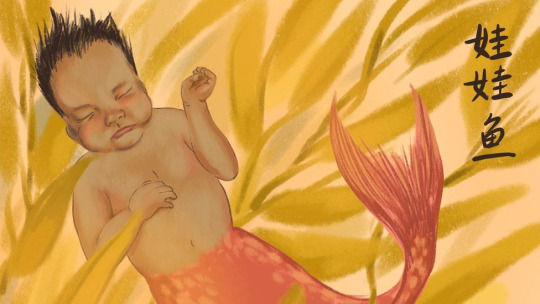
This picture is from a series of paintings by artist Frankie Huang, who depicts a number of Chinese words literally. In this piece, the Chinese giant salamander is shown as the literal translation of its name in China: Wawayu, or ‘Baby fish’. This name comes from the salamanders’ distinct vocalizations, which can often sound like crying babies.
Photos
Theodore Papenfuss
Egon Heiss
Ben Tapley
Frankie Huang (Instagram)
#chinese giant salamander#Urodela#Cryptobranchidae#giant salamanders#salamanders#amphibians#mountains#caves#rivers#freshwater fauna#subterranean fauna#asia#east asia#animal facts#biology#zoology#happy Chinese New Year!#(ik im two days late but i was moving out of my apartment)#(again)
206 notes
·
View notes
Text
Good night everyone sweet dreams I love you all so much :) genuinely I wish I could meet my mutuals irl. I wish we could all meet up and go to an antique store or something and look at all the old items
3 notes
·
View notes
Text
Belgrade Serbia - Music, Galleries, History
Triangle of Serbian National Institutions Nikola Pašić Sq.– Elorna
It will be fantastic returning to Belgrade! Mediterranean resort towns like Datça are healthy and relaxing, but after a rejuvenating stay, I’m happy to be back in a city. The trip from Tukey to Serbia will be tiring – Datça – Marmaris – Istanbul – Belgrade – but I’m not complaining. The worst part is packing heavy winter clothes…

View On WordPress
#Belgrade 2024 Parliamentary Election#Belgrade Philharmonic Orchestra#Belgrade Serbia#Belgrade Splavs#Block 13 New Belgrade#Branko’s Bridge#Cold War Spy Cellars Belgrade#Council of Europe (CoE)#Datça Turkey#Eugster Museum Belgrade#Galerija ŠTAB#Kosovo#Museum of Contempory Art New Belgrade#New Belgrade Philharmonic Concert Hall#Nikola Pašić Square#Saint Sava Cathedral#Salon of the Museum of Contemporary Art Belgrade#Sava River#Savski Venac Municipality Belgrade#Serbia Against Violence (SPN) Coalition#Serbian Academy of Sciences and Arts#Serbian President Aleksandar Vucic#Serbian Progressive Party (SNS)#Stari Grad Municipality Belgrade#Subterranean Walking Tours Belgrade#Ulična Galerija#Ušće Park New Belgrade#Yugoslavia Brutalist Architecture#Zeleni Venac Market Belgrade
0 notes
Text
As relentless rains pounded LA, the city’s “sponge” infrastructure helped gather 8.6 billion gallons of water—enough to sustain over 100,000 households for a year.
Earlier this month, the future fell on Los Angeles. A long band of moisture in the sky, known as an atmospheric river, dumped 9 inches of rain on the city over three days—over half of what the city typically gets in a year. It’s the kind of extreme rainfall that’ll get ever more extreme as the planet warms.
The city’s water managers, though, were ready and waiting. Like other urban areas around the world, in recent years LA has been transforming into a “sponge city,” replacing impermeable surfaces, like concrete, with permeable ones, like dirt and plants. It has also built out “spreading grounds,” where water accumulates and soaks into the earth.
With traditional dams and all that newfangled spongy infrastructure, between February 4 and 7 the metropolis captured 8.6 billion gallons of stormwater, enough to provide water to 106,000 households for a year. For the rainy season in total, LA has accumulated 14.7 billion gallons.
Long reliant on snowmelt and river water piped in from afar, LA is on a quest to produce as much water as it can locally. “There's going to be a lot more rain and a lot less snow, which is going to alter the way we capture snowmelt and the aqueduct water,” says Art Castro, manager of watershed management at the Los Angeles Department of Water and Power. “Dams and spreading grounds are the workhorses of local stormwater capture for either flood protection or water supply.”
Centuries of urban-planning dogma dictates using gutters, sewers, and other infrastructure to funnel rainwater out of a metropolis as quickly as possible to prevent flooding. Given the increasingly catastrophic urban flooding seen around the world, though, that clearly isn’t working anymore, so now planners are finding clever ways to capture stormwater, treating it as an asset instead of a liability. “The problem of urban hydrology is caused by a thousand small cuts,” says Michael Kiparsky, director of the Wheeler Water Institute at UC Berkeley. “No one driveway or roof in and of itself causes massive alteration of the hydrologic cycle. But combine millions of them in one area and it does. Maybe we can solve that problem with a thousand Band-Aids.”
Or in this case, sponges. The trick to making a city more absorbent is to add more gardens and other green spaces that allow water to percolate into underlying aquifers—porous subterranean materials that can hold water—which a city can then draw from in times of need. Engineers are also greening up medians and roadside areas to soak up the water that’d normally rush off streets, into sewers, and eventually out to sea...
To exploit all that free water falling from the sky, the LADWP has carved out big patches of brown in the concrete jungle. Stormwater is piped into these spreading grounds and accumulates in dirt basins. That allows it to slowly soak into the underlying aquifer, which acts as a sort of natural underground tank that can hold 28 billion gallons of water.
During a storm, the city is also gathering water in dams, some of which it diverts into the spreading grounds. “After the storm comes by, and it's a bright sunny day, you’ll still see water being released into a channel and diverted into the spreading grounds,” says Castro. That way, water moves from a reservoir where it’s exposed to sunlight and evaporation, into an aquifer where it’s banked safely underground.
On a smaller scale, LADWP has been experimenting with turning parks into mini spreading grounds, diverting stormwater there to soak into subterranean cisterns or chambers. It’s also deploying green spaces along roadways, which have the additional benefit of mitigating flooding in a neighborhood: The less concrete and the more dirt and plants, the more the built environment can soak up stormwater like the actual environment naturally does.
As an added benefit, deploying more of these green spaces, along with urban gardens, improves the mental health of residents. Plants here also “sweat,” cooling the area and beating back the urban heat island effect—the tendency for concrete to absorb solar energy and slowly release it at night. By reducing summer temperatures, you improve the physical health of residents. “The more trees, the more shade, the less heat island effect,” says Castro. “Sometimes when it’s 90 degrees in the middle of summer, it could get up to 110 underneath a bus stop.”
LA’s far from alone in going spongy. Pittsburgh is also deploying more rain gardens, and where they absolutely must have a hard surface—sidewalks, parking lots, etc.—they’re using special concrete bricks that allow water to seep through. And a growing number of municipalities are scrutinizing properties and charging owners fees if they have excessive impermeable surfaces like pavement, thus incentivizing the switch to permeable surfaces like plots of native plants or urban gardens for producing more food locally.
So the old way of stormwater management isn’t just increasingly dangerous and ineffective as the planet warms and storms get more intense—it stands in the way of a more beautiful, less sweltering, more sustainable urban landscape. LA, of all places, is showing the world there’s a better way.
-via Wired, February 19, 2024
#california#los angeles#water#rainfall#extreme weather#rain#atmospheric science#meteorology#infrastructure#green infrastructure#climate change#climate action#climate resilient#climate emergency#urban#urban landscape#flooding#flood warning#natural disasters#environmental news#climate news#good news#hope#solarpunk#hopepunk#ecopunk#sustainability#urban planning#city planning#urbanism
13K notes
·
View notes
Link
Puerto Princesa underground river
The Puerto Princesa Subterranean River National Park, also known as the Puerto Princesa Underground River, is a UNESCO World Heritage site. It is located on the island of Palawan, in the western part of the country. The underground river is a navigable river that flows beneath a limestone mountain range before emptying out into the South China Sea. It is about 8.2 kilometers long, making it one of the longest underground rivers in the world. Travelers can take a boat tour of the river. Along the way, they will pass through a series of caves and see various rock formations, stalactites, and stalagmites. Visitors may also spot various species of bats, birds, and marine life, including the Palawan turtle.
0 notes
Text
the thing that people are missing about TLT—what makes it so good and so extremely affirmingly gay—is that it is layered through and through with queer desire of all kinds: Sick desire, wrong desire, desire that will never be voiced let alone fulfilled, desire that CANNOT be spoken of, desires that shouldn’t be fulfilled or run counter to social mores of the setting in ways that are alien to the reader’s own. It is So. Horny. People are horny for corpses. They’re fucking using other peoples’ bodies (without consent). They’re subtextually fucking their siblings. The core homoerotic relationship is a necro/cav relationship, which in the book’s setting, romantic or sexual necro/cav relationships are considered repulsive.
And it will never be fulfilled or consummated in the sense that most people imagine them. Nobody is getting what they want. Girls are kissing girls who are in love with someone else’s corpse. Girls are lobotomizing themselves to save other girls’ souls. Girls are spearing their hearts on iron fences and offering their souls to other girls to eat. They are both profoundly Not Getting Laid and also having intimacies and consumptions that make sucking and fucking seem about as profound as a puddle. The penetration metaphor of Naberius’ death and the bottoming metaphor of Gideon’s cannot be overstated. Someone’s arm is amputated and it’s the closest thing that book has to a sex scene.
And somehow, even though it portrays repression in some cases, it is not Repressed(TM). The girls are Jesus; the girls are reading porn rags; the girls are dying as virgins. Someone tries to fuck a hallucination that is also the ghost of the Devil and also of the Earth. The ghost of the Earth and the Devil says “Huh. One moment, I have to cross time, space, and the River beyond death” and roughly… a day later, fully possesses their body.
Sex doesn’t begin to describe it. It is sublime; it is spiritual; it is as crass and visceral and compulsive as whatever sick pornographies anybody gets off to; it is as grimy and solipsistic and subterranean as any human unconscious.
You simply could not get that in a light and happy “found family! ✨” rainbow sci-fi
#the locked tomb#tlt meta#one of these days i will pull out my queer theory readers and do an essay#nona the ninth spoilers#tlt spoilers
3K notes
·
View notes
Text
So growing up I heard these kinds of statements: "X number of species goes extinct every year" and "Most species that go extinct are undescribed/undiscovered"
And I could never really picture what that looked like. What species were going extinct? Where? Why? If they're undiscovered, how do we know about it? It's only recently that I've been able to understand.
This is an example:
Since European colonization, 99% of old growth forest in the eastern United States was cut down.
In Eastern Kentucky, the coal industry led to waste and rubble being dumped in valleys, literally burying countless mountain streams in gravel and toxic sludge.
Colonialism and exploitation moved faster than leaf-sketching and bug-collecting European naturalists did. It's very simple, and very sad. When the coal mines polluted the streams, many species of fish that only lived in one specific stream must have gone extinct. When Native Americans were forced off their lands, we can presume that rare plant species found in meadows, canebrakes and oaks savannas dependent on particular anthropogenic disturbances went extinct. When old-growth tracts were logged, God only knows how many lichens, mosses, ferns and plants went extinct because the trees they lived on were chopped.
We can extrapolate from the diversity in the fragments that remain, and the number of rare endemic species in especially isolated areas, and guess what probably existed in areas that were obliterated early on.
Keep in mind: All is not lost. New species are still being discovered.
The Bluegrass region of Kentucky was once called one of the most peculiar plant communities of the South—an eastern island of oak savanna with an understory of Arundinaria bamboo and legumes. Early European settlers reported that the ground was incredibly rich and covered with knee-high clover and dense thickets of "cane" (bamboo) that made navigation next to impossible.
Some people say the Bluegrass was always a forest and the savanna theory is wrong. Bullshit! I know this because of several reasons:
The earliest records don't mention any sycamores at all in the Bluegrass, whereas river cane (bamboo) was everywhere. Arundinaria bamboos are fire dependent species, whereas sycamore is HIGHLY intolerant of fire. From this we can infer that the area had a history of frequent burning.
Everyone in the Bluegrass knows about the Old Trees. In horse and cattle pastures in the Bluegrass region, you will sometimes see gigantic, twisted old oaks, with great spreading crowns. Nowadays you hardly see an oak that properly merits the term "gnarled," but the gnarl of the Old Trees is crazy. Just look up google images for Kentucky tourism and you'll see one of those huge trees in the background of several of the photos, I bet. Hardly anyone consciously thinks about it, but these are pre-colonization trees. And they are all obviously open-grown—their growth habit over the centuries has spread out, rather than grown straight up as in a forest.
Early colonizers' records report big walnut and cherry trees in the area. Most of the old houses in the area are made of walnut wood. Those are mid-successional species—you wouldn't find them dominating in an area that was heavily disturbed regularly and recently, they're trees, but you wouldn't find them in a forest that had been minimally disturbed forest for centuries either. The fact that they got huge suggests that a regular disturbance pattern of the Bluegrass region was abruptly interrupted and mostly ceased.
It was a pretty special place, a savanna environment with a mix of giant twisted oaks, rolling prairie hills and bamboo thickets, with deep sinkholes connecting the surface to subterranean cave ecosystems. In places the limestone bedrock reached the surface, creating limestone glades—unique desert-like habitats with many rare plants including Opuntia cactus.
It was also one of the first ecosystems west of the Appalachians to be destroyed by settlers.
BUT! Just a few years ago, we discovered Trifolium kentuckiense—Kentucky clover. A unique species of clover that has only been found in two spots in Central Kentucky.
This means the Bluegrass species that probably went extinct because their habitat was ignorantly logged, plowed and grazed before they were studied by European science may not be entirely gone.
We have been able to fund exhaustive inventories of potential holdouts for big flashy animals like the ivory-billed woodpecker, but so many people view the place they live as "boring" and thoroughly explored, when there could be surviving plants hanging out just about anywhere.
But...I don't think most people realize how much of the Holocene extinction has already happened. Most of the losses are plants and bugs that you never knew existed in the first place.
I feel like lots of people are anxiously waiting for the mass extinction to "start" hitting, but that's not quite right. European colonization of the globe WAS and *is* the mass extinction (combined with climate change which is very related). It's actively ongoing in the Global South. In eastern North America, the major wave of extinctions hit between 100 and 300 years ago.
I feel so much grief for all that was almost certainly lost forever, but I also recognize that I live in a unique period of time where the future can still be changed, and in particular, the heavily damaged ecosystems of the Southeast can be restored and used to absorb carbon from the atmosphere and provide resilience to the entire globe. And I strongly suspect at least a few mysterious new plants will start popping up once that happens...because a lot of plants stick around in the soil seed bank for a long, long time, and seeds can happen to be preserved by freak accident and then sprout later.
we (researchers, scientists, people who work in this field) will desperately need to consult tribal nations for this though because from my reading into it, we don't know what the fuck we're doing. The most basic things like controlled burns are still struggling to catch on and in some places just, spraying herbicides willy-nilly on invasive plants without understanding what makes them invasive.
1K notes
·
View notes
Note
Hey, would you be willing to elaborate on that "disappearance of the Anasazi is bs" thing? I've heard something like that before but don't know much about it and would be interested to learn more. Or just like point me to a paper or yt video or something if you don't want to explain right now? Thanks!
I’m traveling to an archaeology conference right now, so this sounds like a great way to spend my airport time! @aurpiment you were wondering too—
“Anasazi” is an archaeological name given to the ancestral Puebloan cultural group in the US Southwest. It’s a Diné (Navajo) term and Modern Pueblos don’t like it and find it othering, so current archaeological best practices is to call this cultural group Ancestral Puebloans. (This is politically complicated because the Diné and Apache nations and groups still prefer “Anasazi” because through cultural interaction, mixing, and migration they also have ancestry among those people and they object to their ancestry being linguistically excluded… demonyms! Politically fraught always!)
However. The difficulties of explaining how descendant communities want to call this group kind of immediately shows: there are descendant communities. The “Anasazi” are Ancestral Purbloans. They are the ancestors of the modern Pueblos.
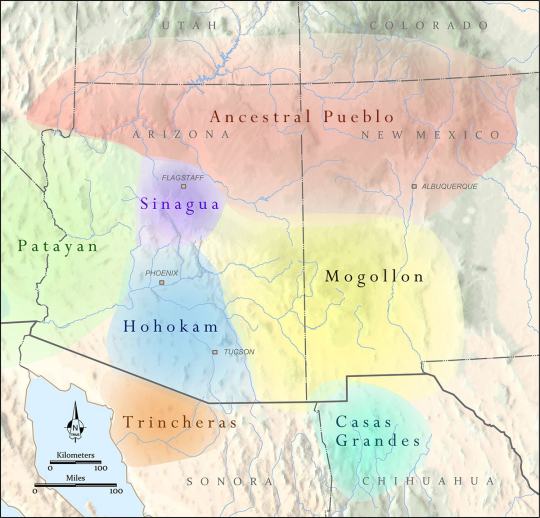
The Ancestral Puebloans as a distinct cultural group defined by similar material culture aspects arose 1200-500 BCE, depending on what you consider core cultural traits, and we generally stop talking about “Ancestral Puebloan” around 1450 CE. These were a group of people who lived in northern Arizona and New Mexico, and southern Colorado and Utah—the “Four Corners” region. There were of course different Ancestral Pueblo groups, political organizations, and cultures over the centuries—Chaco Canyon, Mesa Verde, Kayenta, Tusayan, Ancestral Hopi—but they generally share some traits like religious sodality worship in subterranean circular kivas, residence in square adobe roomblocks around central plazas, maize farming practices, and styles of coil-and-scrape constructed black-on-white and black-on-red pottery.
The most famous Ancestral Pueblo/“Anasazi” sites are the Cliff Palace and associated cliff dwellings of Mesa Verde in southwestern Colorado:

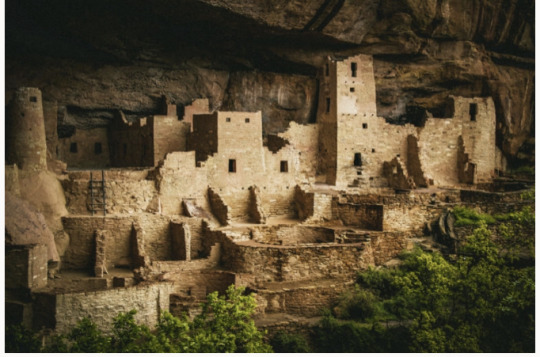
When Europeans/Euro-Americans first found these majestic places, people had not been living in them for centuries. It was a big mystery to them—where did the people who built these cliff cities go? SURELY they were too complex and dramatic to have been built by the Native people who currently lived along the Rio Grande and cited these places as the homes of their ancestors!
So. Like so much else in American history: this mystery is like, 75% racism.
But WHY did the people of Mesa Verde all suddenly leave en masse in the late 1200s, depopulating the whole Mesa Verde region and moving south? That was a mystery. But now—between tree-ring climatological studies, extensive archaeology in this region, and actually listening to Pueblo people’s historical narratives—a lot of it is pretty well-understood. Anything archaeological is inherently, somewhat mysterious, because we have to make our best interpretations of often-scant remaining data, but it’s not some Big Mystery. There was a drought, and people moved south to settle along rivers.
There’s more to it than that—the 21-year drought from 1275-1296 went on unusually long, but it also came at a time when the attempted re-establishment of Chaco cultural organization at the confusingly-and-also-racist-assuption-ly-named Aztec Ruin in northern New Mexico was on the decline anyway, and the political situation of Mesa Verde caused instability and conflict with the extra drought pressures, and archaeologists still strenuously debate whether Athabaskans (ancestors of the Navajo and Apache) moved into the Four Corners region in this time or later, and whether that caused any push-out pressures…
But when I tell people I study Southwest archaeology, I still often hear, “Oh, isn’t it still a big mystery, what happened to the Anasazi? Didn’t they disappear?”
And the answer is. They didn’t disappear. Their descendants simply now live at Hopi, Zuni, Taos, Picuris, Acoma, Cochiti, Isleta, Jemez, Laguna, Nambé, Ohkay Owingeh, Pojoaque, Sandia, San Felipe, Santa Clara, San Ildefonso, Tamaya/Santa Ana, Kewa/Santo Domingo, Tesuque, Zia, and Ysleta del Sur. And/or married into Navajo and Apache groups. The Anasazi/Ancestral Puebloans didn’t disappear any more than you can say the Ancient Romans disappeared because the Coliseum is a ruin that’s not used anymore. And honestly, for the majority of archaeological mysteries about “disappearance,” this is the answer—the socio-political organization changed to something less obvious in the archaeological record, but the people didn’t disappear, they’re still there.
351 notes
·
View notes
Text
All We Do Not Say
Hi beloveds! I have crafted a soft little Gale fic for you because it's my firm belief that everyone's favorite wizard deserves all the warmth in the world. 😌 Also on AO3, if you prefer. As always, thank you for reading. 💕
There was a time in his life that Gale could sleep anywhere, provided he had a good book and a space to sit down.
In Waterdeep, he might wake in his armchair or on his balcony with the weight of an ancient tome still resting in his lap, or at his desk, his cheek pressed against parchment. The smell of it, of ink and lignin, would bring him back to his senses before his eyes were fully open, and he’d recall what he’d been studying, and begin reading again.
At home, in his tower, he could do this night after night and still feel mostly rested come morning.
But he is far from his tower, and farther each day.
Perhaps it is the orb that keeps him up as of late, with its insatiable, unnatural hunger, or perhaps it is the tadpole that wriggles and pulses impatiently inside his skull. Or it could, he supposes, be the simpler and less curable matter of aging– an affliction that seems, on occasion, more frightening than either of the others.
Whatever the cause of his recent insomnia, it pulls Gale into a rather distressing cycle– he cannot sleep, so he cannot focus, so he cannot read, so he cannot sleep.
Instead, he finds himself offering to keep watch over camp in the evenings, if only for the distraction. The far-off gibbering of a newborn gnoll, the crunch of foliage under goblin feet, an animal scream– each night a fresh and distant horror calls his mind away from greater threats, from illithids and tadpoles and gods.
It’s an odd remedy, he knows. But the alternative is lying awake in his tent, turning death over and over in his mind until the thought is worn smooth as a river stone.
It works well for a time, keeps his mind on the present and off of some vague, future doom.
That is, at least, until they reach the Underdark.
Deep beneath Faerûn, there is something profoundly disturbing about the lack of…well, everything. They find no grand cities or quaint little villages, few animals and even fewer people.
No trees, no light. No sky.
Most nights spent underground are so quiet that Gale may as well stay in his bedroll, staring up at a canopy of fabric, dark as the velvet earth above them.
He thinks, It is like being buried alive, without even the stars to bear witness.
On these nights he can feel the stones in his head turning over.
Even so, come the evening (or what he guesses is evening), Gale volunteers to stand sentinel for the fifth time in a tenday.
He always asks them after dinner, when his companions are most likely to agree, after his cooking has warmed them and filled their bellies and made them want nothing more than to close their eyes and dream of somewhere, anywhere else.
Tav is the only one who protests with any frequency, the only one who seems to notice that the circles under his eyes are half a shade darker than they were yesterday, when they were half a shade darker than the day before.
Even on nights when she convinces someone else to take his place, he will relieve them after Tav has gone to sleep.
It starts the same way every time.
Gale walks the perimeter in an infinite loop, looking for life in the darkness, illuminated only by the fire in the center of their camp. It makes him feel like a distant planet, nearly untouched by the sun. How strange to think that he’d once felt like the sun itself.
He continues in his orbit until the subterranean cold gnaws at his limbs. It bites down hard on his nose and ears and fingers, chases him back to the fire, back to the light.
Hypnotized by the flames and their radiant warmth, he does not hear the quiet stirring in the tent beyond his own, doesn’t hear the soft approach of nimble feet.
A voice comes to him out of the darkness.
“I hope you’re not keeping watch again.”
“Mystra,” Gale gasps, startled, the goddess’s name invoked in equal parts a prayer, a curse.
“Forgive me,” Tav says, through a laugh she cannot help. “I didn’t mean to frighten you.”
If it were anyone else he might be annoyed, or even a little embarrassed– but the sound of her laughter bubbles like seafoam over sand, rushes over and around him. Coupled with the relief that she is not some dreadful creature of the Underdark, he finds it difficult to feel anything besides affection.
“It’s quite alright,” he recovers, with a shake of his head. “You surprised me, that’s all.”
“Then I really hope you’re not keeping watch.”
She is teasing him now, just lightly, a familiar spark of warmth behind her eyes.
It is the same look she gives him when she brings him a new book, or when he cooks for her, or when he tells her about Waterdeep. It is the same look she gave him earlier in the day, when she had offered to brew him a tea that might help him to sleep.
Gale has trouble remembering the last time another looked at him this way, so interested and inviting and earnest.
Perhaps, he thinks, another never has.
“Are you alright?” Tav asks, when he’s been quiet for too long.
“Of course,” he says with the sincerity of a promise, offered with a smile that he hopes will be convincing. “Just lost in thought.”
There is a part of him that doesn’t want to leave it there, that wants to share his every thought with her, his every terror, every dream. She must know that there is more to it, must’ve learned by now to recognize when Gale isn’t telling her everything, but he is grateful that she doesn’t press him, never presses him.
Instead she breaks into a grin and says, “You’re lucky I’m not a bulette.”
“I’m lucky they’re not so light-footed. What are you doing up, anyway?”
“The cold always wakes me, sooner or later,” Tav sighs. “If I’d known it was so godsdamned frigid down here, I might’ve nicked a fur or two from the Zhent.”
It’s Gale’s turn to laugh, though she’s only half-joking.
She’s drawn near to him, to the flames, her palms outstretched, her fingers spread wide as if to grab hold of as much warmth as possible.
“But it’s alright,” she continues, “So as long as I’m close to the fire.”
“Any closer and you’ll be in it, I’m afraid. Perhaps I can help.”
Tav tilts her head and quirks an eyebrow in a curious little expression. “Can you?”
“If you’ll allow me.”
Gale turns to face her fully, and she mirrors him out of instinct.
“Hold out your hands to me,” he says. “Palms together, just barely. Like you’re praying.”
“Like this?”
“Like that.”
The spell is one his mother taught him, among the first he’d ever learned.
He still remembers that winter in Waterdeep, when the snow fell hard and fast. When the ice in the harbor kept the ships at arm’s length and the frozen streets shone like glass. He was young then, six or seven, but even now he can feel his small hands in Morena’s, warmed by a word and a touch.
Warm and fed, she used to tell him. That’s how you show someone they’re loved.
Gale cages Tav’s hands lightly in his own, the way he might hold a butterfly. He pushes all thoughts of winter away and calls to mind the rippling heat of summer, an orchard grown fat with peaches, the silvery shimmer of sweat on skin.
The rose-petal flush of a cheek cradled in a hand, her cheek, his hand…
“Calor aestas,” he says quietly, when the image comes into clear view. He feels the cold melt from her fingers, hears the comfortable sigh that follows. “Better?”
“Yes,” she murmurs. “Much.”
She is looking at him now with an intensity he has not seen since the night he first showed her the Weave, all that time ago. The night he saw her thoughts laid bare, had all but felt her lips on his.
Had she seen them now, the visions he had conjured? Had she felt him pull her close in his own mind?
Tav clears her throat softly and he comes back to himself, his heartbeat thrashing wildly in his chest. He realizes with some urgency that he has not let her go and pulls back suddenly, but not without reluctance.
“I hope,” he swallows, trying to compose himself. “I hope it helps you sleep.”
“Do you want me to stay up with you?”
Yes, he thinks selfishly, Yes. Stay up with me, stay close to me, always.
He shakes his head instead. “You should rest while the spell holds.”
“And how long is that?”
“As long as I’m able to concentrate.”
He will think of her hands and their pull on a bowstring, their pluck of a lyre, their grip on a sword. How they weave her own magic, how they cradle a book. How they felt clasped in his, soft and cold.
A focus worth holding, at last.
“Only if it’s no trouble,” she says.
“None at all.”
Gale is grateful that he manages to stop himself, for once, from saying the rest of the thought as it enters his head. I would think of you anyway, magic or no.
Tav takes his hand in hers again, this time to squeeze it fondly.
For a moment, he feels that if he were to die just now– from the orb, from the tadpole, in the jaws of a hungry bulette– it would all have been worth it, for this.
“Thank you, Gale.”
Her smile is warmer than any summer he remembers, brighter than any star he can name.
#gale x tav#gale of waterdeep#gale dekarios#gale romance#gale x reader#gale x ofc#baldur's gate 3#bg3#gale dekarios fanfic#gale fanfic#morena dekarios#bg3 fanfiction#gale bg3#my writing#gale x fem! tav#I hope you love it bc it was a joy to write#I am such a sucker for soft stories#gale fluff#fluff#bg3 fic#gale my beloved#gale dekarios fic
398 notes
·
View notes
Text

it is my honor to introduce you to the waterfall climbing cave fish, a rare species of stygofauna (subterranean river-dwelling creature) from Thailand. A unique limb structure allows it to cling to rock and navigate flowing water.
youtube
[ID: an illustration of a pink and white eyeless fish with four wing-like fins positioned at the sides of its body. it is facing to the left on a textured blue background. drawn around it, there is yellow and orange text reading "waterfall-climbing cave fish". following the drawing is a video of someone describing the cave fish accompanied by photos. end.]
#cave fish#fish#fishes#icthyology#animals#i just love how enthusiastic the speaker in the video is#Youtube
225 notes
·
View notes
Text
I'm not kidding when I say worldbuilding is extremely easy and fun, you can make easily all sorts of new fantasy worlds on like half an hour, follow this guide:
take a rectangle, draw a line through the middle, that's your equator, draw another two lines south and north, those are your tropics, draw another two lines further north (you can see a real world map to guide yourself), those are your arctic/antarctic circles
Draw continents, any shape you want, it's better to combine large soft blobs (like Africa or South America) with coastlines full of peninsulas and islands (like Europe or South Asia). Draw some island chains in between where you feel it's appropiate. Some inland seas like the Mediterranean are good too.
Decide where you will place mountain ranges. In real life, they are where oceanic-continental plates (Andes) or continental-continental plates (Himalayas, Alps), collide. These are very important.
Place rivers, just the most important ones. The places where you place big river systems are gonna be big plains.
Now, the fun part. With your first step, you've already decided where arctic, temperate, and tropical climates are there. You can mark it as letters in your map. Mountain ranges, of course, are colder.
Here's the tricky part: vegetation: vegetation mostly follows precipitation, and precipitation is mostly decided by altitude and distance from the ocean. The interior of your continents should be dry with plains and deserts; the coasts should be rainy with forests and plains. But remember, if you have a mountain range, that's a rain shadow! Picture the wind coming from the ocean with rain, and it should get less rainy when it "clashes" with a mountain range, with the other side a desert.
Deserts are tricky to place, but as a quick cheat, you can place them in your tropic lines. They can even border oceans: see Australia and the Kalahari.
WHEN IN DOUBT, LOOK AT SIMILAR AREAS ON A REAL WORLD VEGETATION/CLIMATE MAP. THIS IS WHY DRAWING THE EQUATOR AND THE TROPICS IS SO IMPORTANT AND SHOULD BE YOUR FIRST STEP ALWAYS.
Now you already have a quick and dirty vegetation map, you're halfway there! Don't worry if there are some doubtful areas, real world geography can be weird.
Now for the REAL fun stuff (if you aren't having fun already, I sure am): making civilizations!
You have to decide center of origins for your domesticated crops and animals. Basically, every early civilization had its own "package" of staple crops and animals that are still used today.
With this, you can decide:
the primary civilizations of your world
roughly how different animals and vegetation are distributed, if you want an Earth-like world (for an quicker method, you can apply the biogeographical realms to your own continents as you wish)
A quick cheat sheet of centers of origin, what they have, and where you can place them:
(this is just a quick thing, do read the article it's so much better)
Middle Eastern: wheat, barley, cows, sheep, goats. Place them in a dry area with lots of rivers (the Fertile Crescent!)
East Asia: rice, soybean, oranges, pigs, horses. Place it in a rainy temperate area bordering the tropics.
Mesoamerica: Corn, beans, pumpkin, chilli, tomato. Place it in a dry area near the tropics.
Andes: Potato, quinoa, llamas. Place it in a mountain range.
Tropical South America: manioc, peanuts, pineapple. In the tropics.
Tropical Asia: Rice, banana, sugar cane, beans. In the tropics, again.
or, just straight up use this fucking map, it's so much better:
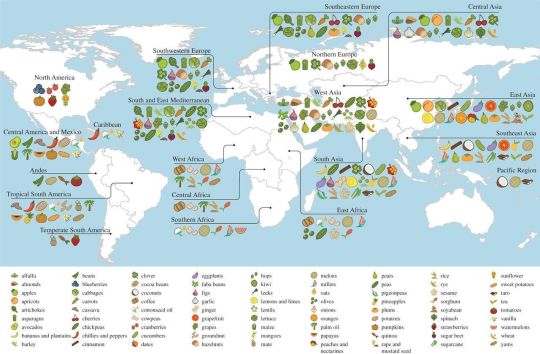
You can mix and match the crops, animals, and such as you wish, and you should definitively read the wiki page on center of origins and see some other less known crops.
If you have non-human civilizations, of course they'll have different packages. Carnivore or subterranean civilizations might be very different. But at this point, your imagination should be flying already and I don't have to hold your hand here.
Now, you have a rough map of your world at the dawn of agriculture! Congratulations! Depending on the historical period you're setting your world, you can start to draw countries and civilizations. This is where it gets complicated again. I might have to make a part two... But just with this, you already have a new world to use as you wish.
I'll make a worked example later to show you how easy it is if you don't believe me.
1K notes
·
View notes
Text
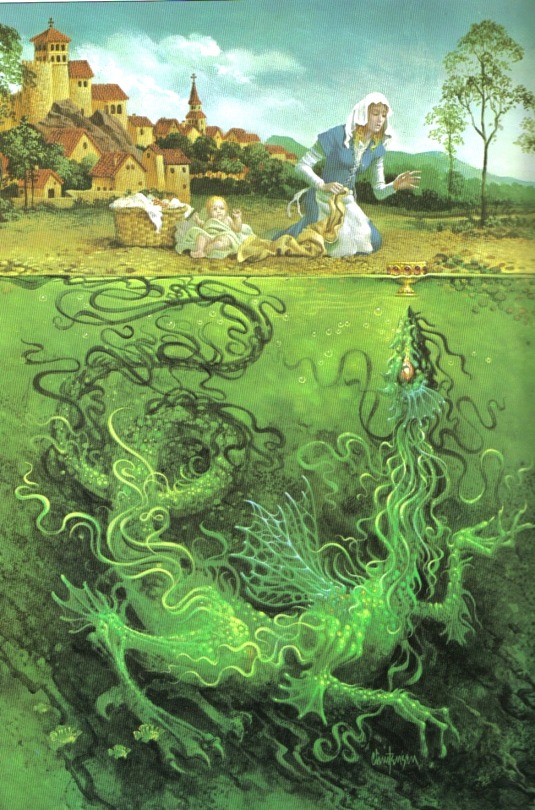
The Drac [French folktales]
The municipality Draguignan in south-east France was originally named Draconeum, and its name was supposedly derived from a local myth about horrible monsters that lived in the nearby river Rhône.
Usually referred to simply as the ‘Drac’, these dragons or dragon-like creatures could shapeshift into the form of a human and walk among the people undetected. They made their homes in underwater caverns along the riverbed and would often shapeshift into golden objects such as cups or rings, in order to attract people. Though they are said to capture children too, their preference goes out to women old enough to lactate.
The drac thus sits beneath the surface of the water in the shape of a desirable golden treasure, enticing women to enter the river. But when they do, the beast grabs them and transports them to its lair where the kidnapped woman is forced to care for the dragon’s offspring as a nurse or maid. These drac caverns aren’t filthy dungeons, rather they are beautiful subterranean palaces. After exactly 7 years of work, the women are usually allowed to return to the world above.
One particular tale tells of a woman who was thus kidnapped and forced to care for young dracs. One day, she accidentally touched her eye with a magical salve or ointment made from eels, after which she gained the ability to see the creatures in their usual, invisible state. But one of the dracs later found out and took this ability away from her.
The story – as described in the 13th century Otia Imperialia – doesn’t tell us what the creatures looked like, however. It is tempting to imagine the dracs as large, scaled reptiles but remember that the word ‘dragon’ was a common umbrella term for evil monsters during this time.
However, these creatures do appear to be reptilian, as the French poet Frédéric Mistral would later describe the dracs as winged reptiles with the head and shoulders of an attractive young man.
Interestingly, the French story of the drac was eventually brought to Great Britain where it gained traction among the Scots and was eventually adapted into Scottish folktales. In this version, the creature was a female fey (in contrast with the French male dragon), but the details of the tale remained the same.
Sources:
Tilbury, G., 13th century, Oria Imperialia. I consulted the 1856 version “Des Gervasius von Tilbury Oria Imperialia” by Felix Liebrecht.
Holman, F., Valen, N. and Walker, S., 1975, The Drac: French Tales of Demons and Dragons, Scribner, USA, 84 pp.
Mistral, F., 1897, Le Poème du Rhône, Paris.
Douglas, G., 1901, Scottish Fairy and Folk Tales, 360 pp.
(image source: James Christensen)
190 notes
·
View notes
Text
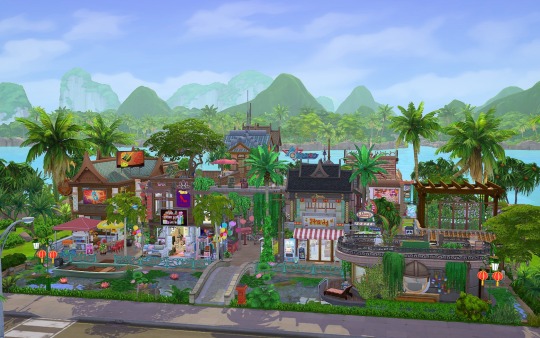

The Happy Home Lot Tour
The Boys arrived here with the Ship December 7th.
That was when we stared to renovate with the machines Other Jeb and Jack left for them.
Before shots -> here and here
The Canal 🚣

The Garden and Greenhouse 🌿

View from the River 🥽

The meadow behind the BarN 🐐🐑🦙
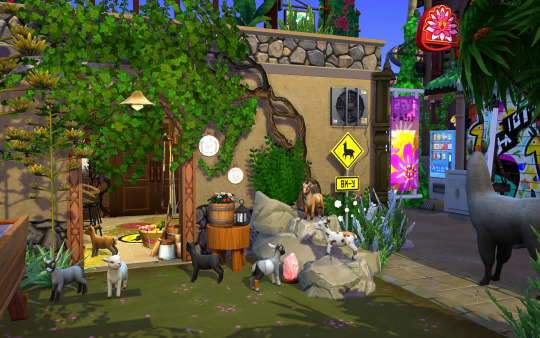
Ground Floor
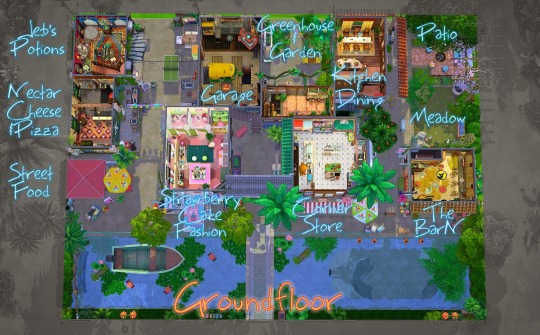
Groundfloor
From left to right
- Jeb's Potions Shop
- Jack's Nectar Shop/Kiyoshi's Cheese Shop
- Streetfood
- Fishing Boat
The Garage
Strawberry Cake Fashion
Jack and Jeb's greenhouse and garden
Kitchen and Dining Room
R̂ān h̄ạw mum (=thai for 'corner store')
Patio and Fireplace
The BarN/Stable
First Floor

First Floor
From left to right
Jeb's apartment (Will be redecorated with Crystal Creations)
Saiwa's Room
Sai and Kiyoshi's Bathroom
Kiyoshi's Room
Ji Ho's Room
Vlad's Bathroom
Vlad's Room
The Hot Tub
Jack's Houseboat
Subterranean Levels
The Sewers

The Cave with the Ship
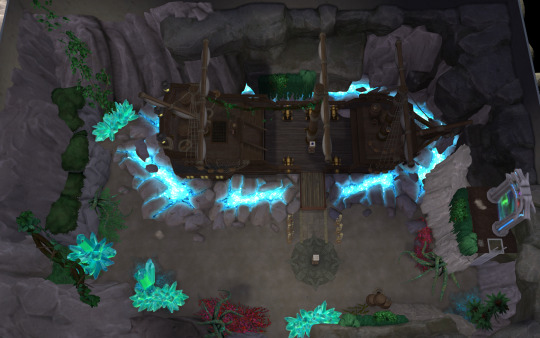
#home happy home#sims 4 story#simlit#sims 4#ts4 story#showusyourbuilds#ts4#simblr#tomarang#underwater love#sims 4 vanilla#The Crappy Home#the sims 4 for rent#sims 4 for rent#for rent
68 notes
·
View notes
Text
A LEGENDARY/MYTHOLOGICAL/SUPERNATURAL CREATURE LIST FOR WRITERS:
(Please note that while I have included a variety of creatures, there are many many others that I haven’t been able to mention here. Had I listed every legendary/mythological/supernatural creature, I’d probably still be writing this post because let’s face it, there are thousands of badass mythological beings. Please also note that there are quite a few creatures that overlap in various categories. I hope that you all enjoy reading and that this helps with your writing!)
Animals:
birds (bird people, caladrius, griffon, harpy, hippogriff, luan, phoenix, roc, sirin, strix, thunderbird.)
canines (amarok, cadejo, cerberus, fenrir, hellhound, werewolf.)
felines (demon cat, griffin, merlion, sphinx, tigris, underwater panther, white tiger.)
fish (hippocamp, undine, water spirit.)
primates (bigfoot, yeti, yowie.)
reptiles/serpents (basalisk, dragon, feathered serpent, hydra, loch ness monster, rainbow serpent, sea serpent, wyvern.)
Elements:
aether (angel, demon, devil, elemental, elf, fairy, nymph, spirit.)
darkness (black dog, bogeyman, ghost, grim reaper, hellhound, vampire, werewolf, wild hunt.)
earth/subterranean (dwarf, earth dragon, gargoyle, giant, gnome, goblin, hobbit, ogre, troll.)
fire (dragon, hellhound, phoenix.)
light/rainbow (light elf, rainbow serpent.)
metal/gold (griffin, gnome, leprechaun.)
thunder/lightning (chinese dragon, cyclops, thunderbird, valkyrie.)
water (chinese dragon, drindylow, loch ness monster, mermaid/merman, nymph, pisces, water dragon, water spirit.)
Habitat:
cave/underground (dwarf, european dragon, gnome, goblin, troll.)
celestial/heaven (angel, feathered serpent, pegasus, grim reaper, swan maiden, valkyrie.)
desert (amphisbaena, chupacabra, cockatrice, ghoul, oliphaunt, sphinx.)
woodland (bigfoot, elf, unicorn.)
lake/river (chinese dragon, hydra, kraken, nixie, lake monster, ondine, rainbow serpent, warlock.)
mountain/hill (dwarf, griffin, hippogriff, hobbit, mountain giant, yeti.)
sea (dragon king, fish people, leviathan, mermaid/merman, sea monster, sea serpent, shen, siren, water dragon.)
polar/ice/winter (abominable snowman, jotun, yeti.)
urban/house (banshee, boggart, jinn, vampire.)
underworld/hell (cerberus, cyclops, demon, devil, earth dragon.)
Humanoids:
human skinned (brownie, dwarf, elf, fairy, giant, gnome, gremlin, jinn, leprechaun, nix, nymph, pixie, siren, valkyrie, vampire, vetter.)
monster skinned (banshee, boggart, centaur, demon, ent, goblin, imp, manticore, mermaid/merman, orc, siren, sphinx, troll.)
monstrous (baba yaga, boogeyman, cyclops, gargoyle, ghoul, giant/giantess, goblin, hag, jotun, mummy, ogre, oni, orc, titan, troll, yeti, zombie.)
Hybrids:
part human (angel, centaur, fairy, faun, gorgon, harpy, horus, meduza, mandrake, manticore, mermaid/merman, minotaur, siren, sphinx, tenju, triton, winged genie, werecat, werewolf.)
non-human (basilisk, capricorn, cerberus, chimera, griffin, hippogriff, merlion, pegasus, typhon, wyvren.)
Shapeshifters: (animagus, demon, kelpie, merpeople, nix, werecat, werehyena, werejaguar, werewolf.)
Undead: (banshee, ghost, ghoul, frankenstein, headless horseman, mummy, poltergeist, skeleton, spirit, vampire, wraith, zombie.)
#writing prompt#writing ideas#writing tips#creative writing#writers of tumblr#writers block#writing things#writers#writing advice#creatures#mythological creature#legendary creature#fantasy creature#high fantasy#myth#mythical creatures#mythical beings#mythical beasts#mythical animals#monsters#supernatural
2K notes
·
View notes
Text
They're really pulling some niche figures for these new Personas, huh?
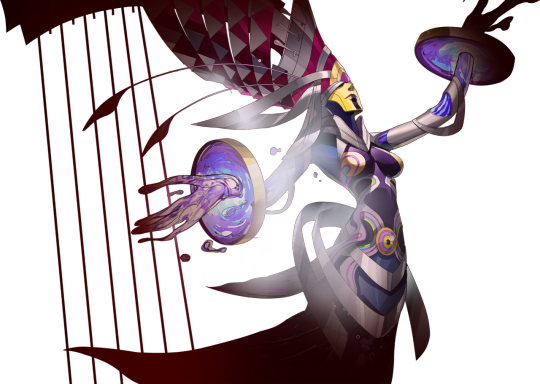
Prosymna is one of three naiad daughters of the Greek river god Asterion. Along with her sisters (Acraea and Euboea), she served as a wet-nurse for Hera. The name Prosymna means "celebrate in song," which explains her harp-like design.
(Prosymna is also a genus of snake!)

Erytheia is one of the three (or four, or seven) Hesperides, nymphs who presided over evening and sunsets. The name Erytheia means "the red one." There doesn't seem to be much mythos surrounding Erytheia specifically, but her name was assigned to a small island northwest of Gilbraltar. (Nowadays it's part of Spain! The city of Cadíz can be found there.)
Preceded by Leucothea, Erytheia is one of the two (possibly 3?) P5X Persona to be rendered as a masculine entity despite being based off a distinctly feminine mythological figure. Not sure why they're doing that, but hey, the designs are great!

Syke is a bit of an oddball. While it would be easy to presume it's meant to represent Psyche, the Greek goddess of the soul…Psyche has already appeared as Metis' Persona back in P3 FES, so it's possible this one is a different entity. However, something worth noting: like the other Greek myth Persona in this post, Psyche came in a set of three, having been the youngest of three sisters.
Of what I've been able to dig up, Syke (or Syca) was also the name of a town in ancient Cilicia, a region in southern Anatolia. Another name for Syke was Setos, possibly based off the primordial sea goddess Ceto. Ceto is considered one of the oldest-known deities in Greek myth, and was mother to a myriad of monsters, such as the Graiae and Gorgon sisters.

Meng Po is the Chinese goddess of forgetfulness, tasked with ensuring that souls headed for reincarnation are reborn with no memories. To accomplish this, she serves a memory-wiping soup to souls crossing the Naihe Bridge out of Diyu, a subterranean maze that serves as an equivalent to hell in Chinese mythology.
This lore explains both the bowl and lantern in this Persona's design. The bowl represents the soup, obviously enough, while the lantern can be interpreted as symbolic of "guiding the dead."
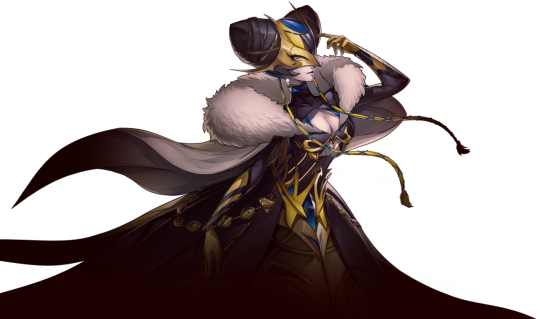
Cleodora was one of the three Thriae, prophetic nymphs who lived in the Corycian Cave of Mt. Parnassus. Though the Thriae are often considered to be the "bee-maidens" (women bearing human heads/torsos and bee wings/lower bodies) described in the Homeric Hymn to Hermes, it's possible they're different trios; the Thriae predicted the future through throwing stones (pessomancy/mantic pebbles), while the bee-maidens predicted the future through casting lots (cleromancy).
The only info I can find on Cleodora as separate from the Thriae states that she was the mother of Parnassos, who invented a way to predict the future based on birds (ornithomancy).
#persona 5 x#p5x#persona 5 the phantom x#prosymna#erytheia#syke#meng po#cleodora#Kidd speaking#not aesthetic
179 notes
·
View notes